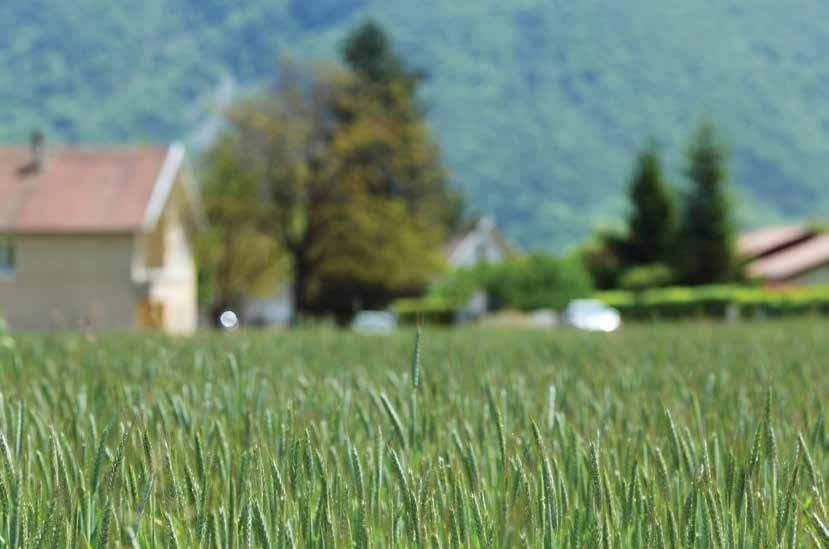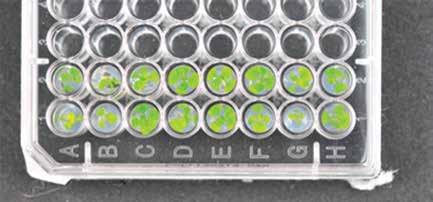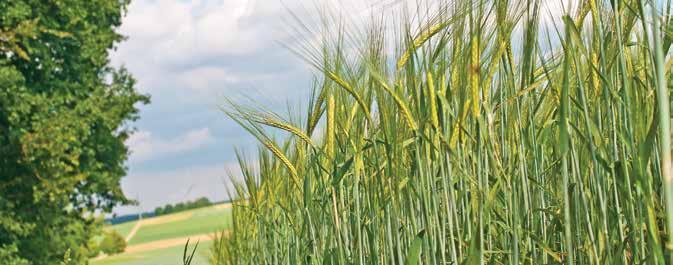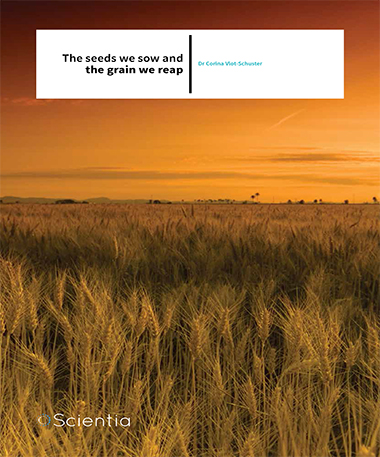Dr Corina Vlot-Schuster – The Seeds We Sow And The Grain We Reap
Much of the world’s population is dependent on just a few crops, with blight and disease an ever-present threat. Dr Corina Vlot-Schuster of the Helmholtz Centre Munich, after many years researching plant defences against pathogenic attack, aims to open the door to disease-proof crops.

Crops can fail for numerous reasons. Drought can occur, turning the land to windblown dust, or there could be flooding, which sucks oxygen from the soil and turns cropland into rotting bogs. More commonly crops can be attacked by pathogens – plant specific diseases and infections which lead to rotten chunks of fruit, stunted crops, and dead plants.
Between 1988 and 1990, failure of our eight major crops (which collectively comprise half of the global croplands) has cost us an estimated 300 billion dollars worldwide. Furthermore, about 65% of crop losses in the U.S. are caused by nonindigenous pathogens, totalling to a cost of about 137 billion dollars every year.
Molecular thorns
 Plants, of course, have been around for a very long time (over 400 million years, in fact), and in that time have often been attacked by disease. Thus, as you would expect, they have developed a number of systems to help fight off pathogens, and these systems are a promising area of research for scientists trying to develop disease-free crops. One such defensive system is known as Systemic Acquired Resistance, or SAR, and the name itself is a good description of what it does: SAR is systemic because it affects the entire plant, not just the section currently under attack; acquired because it can be activated or induced by the presence of pathogens; and resistance because, well, it heightens plant resistance to attack.
Plants, of course, have been around for a very long time (over 400 million years, in fact), and in that time have often been attacked by disease. Thus, as you would expect, they have developed a number of systems to help fight off pathogens, and these systems are a promising area of research for scientists trying to develop disease-free crops. One such defensive system is known as Systemic Acquired Resistance, or SAR, and the name itself is a good description of what it does: SAR is systemic because it affects the entire plant, not just the section currently under attack; acquired because it can be activated or induced by the presence of pathogens; and resistance because, well, it heightens plant resistance to attack.
 The most important factor here is the ‘inducible’ part. Unlike many other defensive systems, SAR is only turned on when the plant is actually under attack. SAR activation is triggered by the presence of the ‘stress hormone’ salicylic acid (which you may recognise as the active metabolite of aspirin), which itself is often associated with the detection of pathogen-associated molecules by specialised receptors in a process which is somewhat similar to our own immune response.
The most important factor here is the ‘inducible’ part. Unlike many other defensive systems, SAR is only turned on when the plant is actually under attack. SAR activation is triggered by the presence of the ‘stress hormone’ salicylic acid (which you may recognise as the active metabolite of aspirin), which itself is often associated with the detection of pathogen-associated molecules by specialised receptors in a process which is somewhat similar to our own immune response.

‘I started working on systemic acquired resistance around 12 years ago and was immediately grasped by the challenging complexity of this biological response, but also by the potential to work towards applied sciences’
Any defensive system has what is known as an ‘energy cost’, in that energy which is being used to help protect the plant is not being used for getting larger, making seeds, growing delicious fruit, etc. Thus plants which are constantly defending against attack cannot produce the same yield as those which are untouched, and similarly plants which are bred to constant defence will never be as high-yielding as those which are not. Here the advantage of SAR’s inducible nature comes into play, as it has a low energy cost in the ‘waiting’ mode, only rising when it is actually needed. As you would expect, an inducible system of this sort is highly complex, with multiple interacting proteins and molecules controlling the final outcome.
Seeing the wood for trees
Attempting to decipher some of this complexity is Dr Vlot-Schuster, of the Institute of Biochemical Plant Pathology at the Helmholtz Centre Munich in Germany. Bringing many years’ experience in plant pathogens and the resultant responses, she has recently been working on unravelling the SAR system in vital crop species such as barley and wheat.
The initial work began in every scientists’ favourite plant, Arabidopsis thaliana. A small plant with a fast lifecycle, it is a common model organism for botanical research in the same way that particular mouse breeds are common models for mammalian research. Dr Vlot-Schuster’s early work examined the SAR system in Arabidopsis, identifying several proteins which had effects on the activation process. They also utilised metabolic profiling alongside this, essentially a method of fingerprinting a biological state based on chemical entities present (i.e. not just ‘you have high blood-glucose levels’ but ‘based on the presence of these glucoserelated metabolites, you have disease X’). The researchers were able to show a distinct ‘SAR signal’, several small compounds which were able to help modulate salicylic acid’s activation of the SAR process – a vital step on the road to controlling the system ourselves.
Practical for inducing SAR in Arabidopsis, certainly. Arabidopsis, however useful as a model, is not particularly relevant to feeding humans. Dr Vlot-Schuster thus decided to move onto newer pastures, as she commented: ‘SAR was well-characterised in Arabidopsis thaliana whereas little was known about SAR in crop plants.
So, around seven years ago, post-doc Dr Sanjukta Dey and technicians Marion Wenig and Claudia Knappe in my lab started transferring experimental methodologies from Arabidopsis to barley.’ This was more complicated than it sounds, barley and Arabidopsis have different lifecycles, proteins, underlying genetics, even the genome of barley is about 40 times larger than that of Arabidopsis.
Their hard work paid off, however, with the identification of SAR-like systems in barley, and it was a lot of work, as Dr Vlot- Schuster says: ‘Currently we are the first and only group to have established a SAR-like pathosystem in this cereal crop’. These are not true SAR systems in the original sense of the word, as they do not appear to be activated by salicylic acid. Instead, the call for help is transmitted by transcription factors, small proteins which act to turn specific genes or sets of genes on and off. Specific activation of genes is a key part of many long-lasting responses to environmental stimuli, the typical example given here is the increased transcription by bacteria of heatshock- proteins (which help proteins to fold) following a period of higher temperature (which unfolds proteins).
So barley has a SAR-like defence system – why is this important? Dr Vlot-Schuster was happy to comment on the applicability of this research: ‘Plant disease resistance signals can be or become relevant for crop protection. Because SAR is exceptionally resource-efficient (no or very limited yield costs), signals that are involved in this particular disease resistance process are likely to be good candidate molecules to be incorporated in future crop protection schemes using plant-derived defence compounds rather than toxic pesticides that are in use today.’ The discovery of transcription factor elements in the barley SAR response indicates that there are multiple proteins which could be targeted by these candidate ‘plant pharmaceuticals’, significantly improving the chances of success.
Peas in a pod
As with many areas of agriculture-related science, plant defence research has to develop in order to join basic studies with on-field application. In this regard, plant phenotyping – basically the identification of unique individuals from a large collection by analysing the most important traits – has become vital on an international scale. The working group of Dr Vlot- Schuster develops novel tools for analysing plant defence phenotypes with the aim of overcoming the often tedious work of manually screening libraries of plants. Of course, no scientist does their best work alone, and Dr Vlot-Schuster is no exception. She is currently part of the German Plant Phenotyping Network (which goes by the acronym DPPN, for the German ‘Deutsches Pflanzen Phänotypisierungs Netzwerk’). This network covers three sites within Germany: The Forschungszentrum Jülich, the Leibniz Institute of Plant Genetics and Crop Plant Research in Gatersleben and her home institute, the Helmholtz Centre Munich. ‘Here in Munich we have several platforms, most prominently the highly acclaimed environmental simulation unit and a recently adapted unique volatile organic compound (VOC) analysis platform as well as the platform in my lab, which is currently called SignalSCREEN. This installation, which will also be accessible for external users, can screen seedlings of different plant species for susceptibility to fluorescently marked pathogens,’ Dr Vlot-Schuster explains.
‘Plant disease resistance signals can be or become relevant for crop protection. Because SAR is exceptionally resource-efficient, signals that are involved in this particular disease resistance process are likely to be good candidate molecules to be incorporated in future crop protection schemes using plant-derived defence compounds rather than toxic pesticides that are in use today.’

SignalSCREEN is based on high-throughput confocal microscopy, essentially the ability to use a very high magnification microscope on many thousands of different samples in a very short period of time. High-throughput methods are very popular with pharmaceutical companies, who use them to screen libraries of chemicals for potential new drugs. As each chemical library can contain hundreds of thousands of compounds, high-throughput systems use extensive levels of robotic and software automation, to the point where the machine can often run the entire experiment itself. Confocal microscopy methods are usually paired with fluorescent labelling techniques, in this case for example, plant pathogens are provided with a fluorescent protein (GFP)-tag which allows them to be easily spotted under the microscope – wherever the camera sees brightly coloured spots, that’s another pathogen eating away at the plant. Transferring such a sophisticated method to a high-throughput scale is a novelty and provides us with the possibility to find resistant individuals in a pool of susceptible plants, thus defining points of action to use natural defence in plant breeding strategies.
Developed in collaboration with Carl Zeiss Microscopy GmbH and Analytik Jena AG, the quantitative approach of SignalSCREEN qualifies it as a state-of-the-art phenotyping platform. It speeds up a specific experimental setup so that no scientist needs to sit in a dark room for weeks to screen a collection of plants. However, it is the emphasis on networking that elevates Dr Vlot-Schuster’s strategy to go beyond basic research and bridge the gap towards field application. Because it is such a new area, it provides the very real possibility that the Helmholtz Centre Munich as part of the DPPN will become a focal point and leader for research in this field – certainly Germany-wide, and perhaps throughout Europe.
Budding plans
So where to from here? Dr Vlot-Schuster plans to combine both traditional biochemical methods with the high-throughput options provided by the DPPN network. Her comments are typically modest, aiming ‘to of course continue investigating barley SAR-like immunity at the molecular level. However, we will also apply our phenotyping platform, which can help us further in applied directions.’ The ultimate goal is to be able to control the SAR process in barley, wheat, and other vitally important crops – perhaps using specially developed molecules which would act as ‘plant pharmaceuticals’. By turning the SAR defence system on and off at will, farmers could quickly change their plants between growth and defence mode, leading to better yields and less chance of crop failure. And thus, in the long run, a safer future for all of us.
Meet the researcher

Dr Corina Vlot-Schuster
Helmholtz Zentrum Muenchen
Department of Environmental Sciences
Institute of Biochemical Plant Pathology
Munich, Germany
Hailing from the Netherlands, Dr Corina Vlot-Schuster currently works at the internationally renowned Helmholtz Centre Munich, a research centre for Environmental Health that is part of the Helmholtz Association of German Research Centres. Her research career began in the field of mammalian viruses, but she soon changed track to target plant viruses and other pathogens. A successful research career followed, leading to over 20 publications to her name, numerous successful grant applications, and rapid advancement. She is currently a group head at the Helmholtz Centre Munich Institute of Biochemical Plant Pathology, where she leads the Inducible Resistance Signalling laboratory.
CONTACT
KEY COLLABORATORS
Professor Robin K. Cameron, McMaster University, Hamilton, Canada
Dr Jafargholi Imani and Professor Karl-Heinz Kogel, Justus-Liebig- University Gießen, Germany
Plant pathology in DPPN:
Professor Joerg-Peter Schnitzler, Helmholtz Zentrum Muenchen, Institute of Biochemical Plant Pathology, Research unit Environmental Simulation, Germany
Dr Patrick Schweizer, Leibniz Institute of Plant Genetics and Crop Plant Research, Gatersleben, Germany

FUNDING
Work in the Vlot-Schuster lab is currently funded by the Deutsche Forschungsgemeinschaft (DFG) as part of the collaborative research centre SFB924 and by the German federal ministry of education and research (BMBF) as part of DPPN (grant No. 031A053C).


REFERENCES
P Carella, J Merl-Pham, DC Wilson, S Dey, SM Hauck, AC Vlot, RK Cameron, Comparative proteomics analysis of Arabidopsis phloem exudates collected during the induction of systemic acquired resistance, Plant Physiol., 2016, 171, 1495–1510.
F Wittek, B Kanawati, T Hoffmann, M Wenig, K Franz-Oberdorff, W Schwab, P Schmitt-Kopplin, AC Vlot AC, Folic acid induces salicylic acid-dependent immunity in Arabidopsis and enhances susceptibility to Alternaria brassicicola, Mol. Plant Pathol., 2015, 16, 616–622.
S Dey, M Wenig, G Langen, S Sharma, KG Kugler, C Knappe, B Hause, M Bichlmeier, V Babaeizad, J Imani, I Janzik, T Stempfl, R Hückelhoven, K-H Kogel, KFX Mayer and A Corina Vlot, Bacteria-Triggered Systemic Immunity in Barley Is Associated with WRKY and ETHYLENE RESPONSIVE FACTORs But Not with Salicylic Acid, Plant Physiology, 2014, 166, 2133–2151.
F Wittek, T Hoffmann, B Kanawati, M Bichlmeier, C Knappe, M Wenig, P Schmitt-Kopplin, JE Parker, W Schwab, AC Vlot, Arabidopsis ENHANCED DISEASE SUSCEPTIBILITY1 promotes systemic acquired resistance via azelaic acid and its precursor 9-oxo nonanoic acid, J. Exp. Bot., 2014, 65, 5919–5931.
HH Breitenbach, M Wenig, F Wittek, L Jorda, AM Maldonado-Alconada, H Sarioglu, T Colby, C Knappe, M Bichlmeier, E Pabst, D Mackey, JE Parker, AC Vlot, Contrasting roles of apoplastic aspartyl protease APOPLASTIC, ENHANCED DISEASE SUSCEPTIBILITY1-DEPENDENT1 and LEGUME LECTIN-LIKE PROTEIN1 in Arabidopsis systemic acquired resistance, Plant Physiol. 2014, 165, 791–809.

